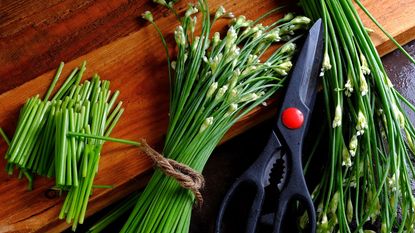Garlic Chives Information


When King Tutankhamen's tomb was excavated, well preserved garlic cloves were found. The ancient Egyptians revered the pungent bulb, as do many of us today, with the exception of people having alliumphobia, or fear of garlic. If you fear garlic's strong aroma and taste, try growing garlic chives.
Garlic Chives Information
Garlic chives (Allium tuberosum) are perennial plants also referred to as Chinese chives, which impart a mild garlicky/oniony flavor to a variety of dishes. Commonly found in Asian cuisines, garlic chives can be found in salads, soups, soft cheeses, herbal compound butters, herbed vinegars and grilled meats. Garlic chives history finds the herb as being first recorded between 4,000 and 5,000 years ago in China. Otherwise, I wasn't able to locate additional information on its history, but it seems a safe bet that it is one of the more ancient herbs still in use today. Garlic chive information that is readily available references its uses medicinally. Although we tend to use it in foods here, in other countries, such as India, garlic chives have a plethora of medicinal uses. The herb has been used as an antibacterial, to treat cardiac ailments, as a depurative, digestive, stimulant, tonic and to treat stomach aches. It is used to improve kidney functions along with urinary incontinence. The foliage as well as the bulb are applied topically to bites, cuts and other wounds.
Growing Garlic Chives in Gardens
Growing garlic chives differ from regular chives in that they have flat versus hollow leaves. Otherwise, the two look similar. The plant arises from a rhizome and becomes a clump of 28-inch or so stalks. From these stalks, small, star-shaped white flowers are produced. In USDA zones 8 or warmer, garlic chives may be green year round, but in USDA zones 7 and cooler, the plants die back only to return in the spring. This herb is easy to grow and will readily self-sow unless deadheaded; remember, you can eat the flowers! Divide plants in early spring or start seed in the spring in a cold frame. Snip back and use the leaves fresh from spring through late summer or early fall.
Gardening tips, videos, info and more delivered right to your inbox!
Sign up for the Gardening Know How newsletter today and receive a free download of our most popular eBook "How to Grow Delicious Tomatoes."

Amy Grant has been gardening for 30 years and writing for 15. A professional chef and caterer, Amy's area of expertise is culinary gardening.
-
 How To Grow Garden To Table: A Guide For Home Cooks
How To Grow Garden To Table: A Guide For Home CooksWhat could be better than a meal that comes directly from garden to table? Show off your gardening and culinary skills with the very freshest food.
By Bonnie L. Grant
-
 Want a Backyard Mini Orchard? Create Your Own Container Orchard
Want a Backyard Mini Orchard? Create Your Own Container OrchardEasier to care for in small spaces, a backyard mini-orchard makes sense for busy gardeners and juicy fruit is the reward.
By Teo Spengler